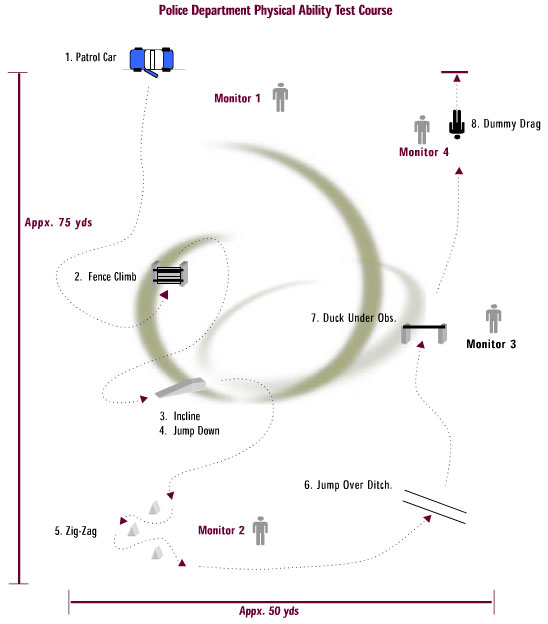
If you have chosen the career of a police officer, you are likely aware that there is a specific selection process you need to pass. One of the hurdles each candidate is faced with is the physical ability test (PAT).
This is a standard component that is present in the admission process for police officers, however the components it covers may vary a bit from department to department. If you want to make sure that you pass the PAT, it is recommended that you know what it contains and learn a few tricks how to prepare for it.
You should know that typically, you need to pass the police written exam first and then the PAT. In some cases, however, the agencies prefer to ask candidates to go through the PAT first in order to save some of the costs for administering the written test.
Two approaches to the physical ability test
The first thing you need to know about the physical ability test is that there are two different methods for assessing your physical ability, used by the police departments: the job simulation method and the fitness-based method. The components of the PAT based on either of the methods are different, however in both cases it is a generally a pass or fail test. You need to fulfill certain criteria and collect a given number of points in order to be able to pass the test and continue on with the selection process. In most cases, failing even one component means that you are not allowed to continue further with the test.
So, what do the different methods focus on?
- The job simulation method
As evident from its name, the job simulation method tests the ability of the candidate to cope with real-life situations. This means that you will be faced with physical simulations that are often present in the job of the police officer, such as running at a short distance, dragging a body, climbing up and down the stairs or overcoming obstacles such as walls and windows. The aim is to assess whether the applicant meets the physical requirements for becoming a police officer by coping with physical simulations that mirror the actual activities performed while on duty.
The police department usually has an established specific course with obstacles to test the candidates. Each applicant is required to pass through the different hurdles/tasks on the course for certain time.
- The fitness-based method
The agencies that prefer this type of tests check the number of push-ups, for example, a candidate can perform over a given period of time. While the test doesn’t include simulation of actual police tasks, it does check the overall physical fitness of the person. Some agencies argue that it is the better approach since it provides information about the overall fitness and physical abilities of the candidates and is an indicator, whether they can take proper care of themselves.
The test includes multiple components that are checked. Quite often agencies use the Copper Institute fitness standards to measure the performance of the candidate. These standards take into account the gender and age of the candidate and determine how many repetitions of each exercise a male or female needs to perform or how quickly to cover each activity in order to pass the test.
What does the physical ability test for police officers include?
Based on the approach chosen by the police department for preparing its PAT, it may include the following activities:
- Components of the physical ability test based on the job simulation method
This type of PAT is performed over a specifically designed obstacle course. The candidate needs to cover all the activates included in the course in one go for a certain period of time. The components included in the course vary for the different agency but most commonly include the following:
- Get out of a patrol car, while your seatbelt is on
- Run certain distance
- Climb or jump over a wall
- High step over several low hurdles
- Drag a dummy weighing 150 pounds for 50 feet
- Belly crawl
- Stair climb and decent
- Climb through a window
You will receive detailed instruction prior to covering the course on how to approach the different obstacles, what is allowed and what is a disqualifier. For some activities, you may be allowed a second or a third attempt, while others activities must be passed the first time.
The two main requirements for this model are: the test activities should be linked to actual job tasks and there should be an appropriate timed cut-off score.
An example of an obstacle course may look like the diagram below

Source: Stanard & Associates
- Components of the fitness-based physical ability test
Again, each department has the right to decide how many and which components to include in its fitness-based PAT. The most common ones, however, include:
- Push-ups
- Sit-ups
- Bench-press
- Additional strength assessment – trigger pull, arm ergo-meter, sit/reach extensions
- 75-yard dash
- 1.5-mile run
In order to pass the test, the candidate needs to perform each activity according to a given standard. There is usually a scale that shows the expected results depending on age and gender. Respectively, there is a score table that shows how many scores you receive depending on your performance.
The candidates must fulfill each activity otherwise they are disqualified. In some cases, there is a certain amount of points that need to be reached in order for the candidate to be successful but in general it is a pass/fail test.
In addition to that, many police departments have specific requirements about the height and weight of the candidates. Make sure to ask for this information in advance.
No matter which of the two methods is used for the PAT, all candidates generally must get medical clearance from their physician before they participate in it. Agencies should include the medical waivers as part of their physical ability testing process.
Who develops the physical ability test for police officers?
As we already mentioned, each agency has its own specific physical ability test. It may be based on either of the two popular methods and respectively checks whether the candidate can perform activities simulating real job duties or the overall fitness of the applicant.
There are many consulting companies that help with the preparation of valid physical ability tests, which can be used by agencies hiring police officers or firefighters. The tests should be developed in such a way so that they are a fair tool for checking the abilities of the candidates and differentiating between qualified and unqualified candidates.
Usually, the company developing the PAT, ensures that there are training manuals that will guarantee that the agency using the test will administer it properly.
In addition, there also many manuals or guides that can help in the process of preparing the right PAT. An example is the work of Arvey RD, Landon TE, Nutting SM, Maxwell SE – “Development of physical ability tests for police officers: a construct validation approach“, which gives an insight of how different activities are selected and tested, prior to being approved as part of a physical ability test.
How to prepare for the physical ability test?
As any other test, the PAT also requires some preparation in advance if you want to make sure that you will pass it successfully. Many agencies have prepared a special manual or video training guides that can help the candidates pass the physical ability test. Some departments even organize live trainings prior to the test.
The first thing you need to do in order to prepare properly for the test, is to check with the agency which test they are using – the obstacle course or the fitness-based test. Afterwards, based on the type of the test, you can start your preparation.
In the agency uses an obstacle course, check their site for any manuals, trainings, videos or further information what exactly the course contains. Thus, you will know what to expect and how to best prepare for it. If possible, try to set a mock obstacle course and train on it.
If the agency uses the fitness-based test, then it is time for you to hit the gym. Once again, make sure to check which components are used to test your fitness and do exercise them – push-ups, sit-ups, bench press, etc.
In both cases there is running, so if you are not much of a runner, you need to start. The PAT will test both your stamina and endurance. So, one way to begin running is at the treadmill in the gym. There you can run for one minute and then walk for one minute and so on. There is also the option to go to the park and alternate running and walking.
Keep in mind that the physical ability test checks whether you are fit to perform the duties of a police officer and not whether you are a fitness fan. As a police officer you won’t wear comfortable sweat suits to run through the park but chase a suspect with all your gear, jump over fences, avoid dogs, etc. Quite often the police officer needs to get physical with a suspect who is aggressive or under the influence of alcohol or drugs.
Therefore, it is very important to have the right mindset when you show up on the day of the physical exam test. Go in your best mood, determined to perform all the tasks you are required to, in order to become a police officer.
Specific examples of physical ability tests used by different police departments
As we have already mentioned, each department develops its own specific physical ability test. In order to be prepared for it, you need to check with the agency what type of PAT they are using and which are the specific components.
If you still haven’t chosen the department you want to work in, below you will find a few examples of physical ability tests used by different agencies. They will give you an idea of what you could expect at your PAT.
- Springfield Police Department’s Police Academy in Springfield, Missouri
Many agencies have prepared a video presenting the course that will be used during the physical ability test. You can find such videos with lots of specific information in YouTube. Here is the example of the Springfield Police Department’s Police Academy:
Click here to view video
- Miami Police Department
The Miami Police Department has developed a detailed training manual that can help the candidate prepare for the PAT. This department has chosen the fitness-based test and provides specific details on which exercises are include, what is the passing point and gives ideas how to prepare for each of it. It is a very comprehensive guide that will be useful for the candidates, even if they have chosen a different department and not that in Miami.
Click here to download it in pdf
- Metropolitan Police, Washington D.C.
The Metropolitan Police Department has developed a physical ability test that is based on the job simulation method. In order to help candidates prepare, the department has published a guide with comprehensive instructions on how to prepare for the test, what to expect, what to wear on the day of the test. Despite being a bit old (prepared back in 1996), it is a useful read for all candidates.
Click here to download it in pdf
The conclusion is that the physical ability test should be regarded as any other of the components of the police officer hiring process. Make sure to understand and prepare for it in advance in order to increase your chances of success. Once you start browsing the job openings for police officers, you should be aware that you need to develop a plan for each step of the application that allows you sufficient time to get ready for each test you are about to face. Finding out what to expect is the first step to success, your motivation for the job is the rest.

 Joseph Libowsky,
Joseph Libowsky,